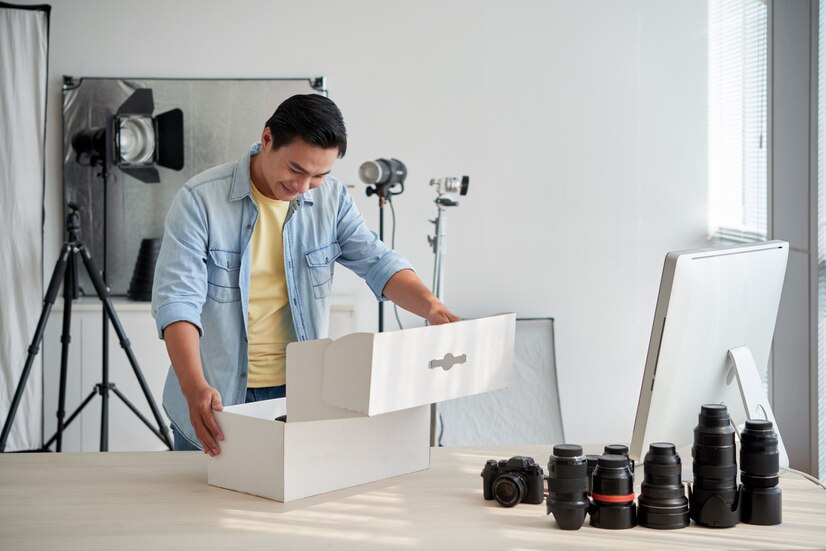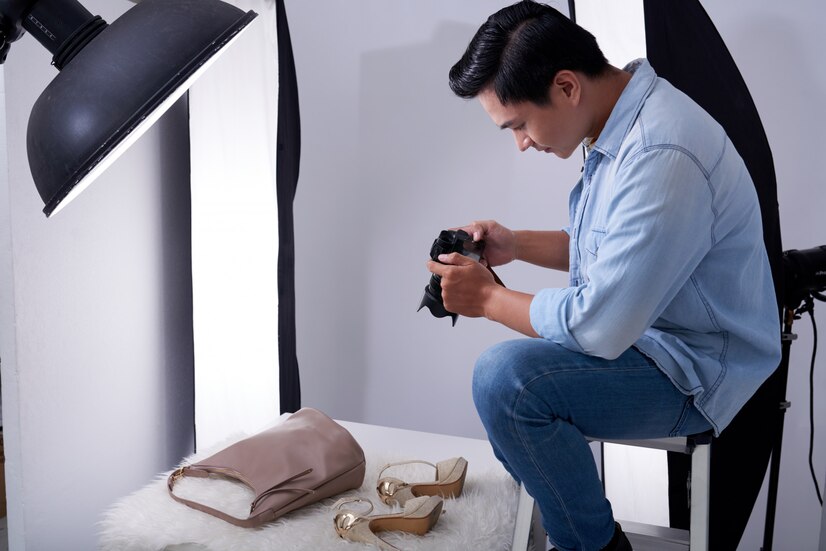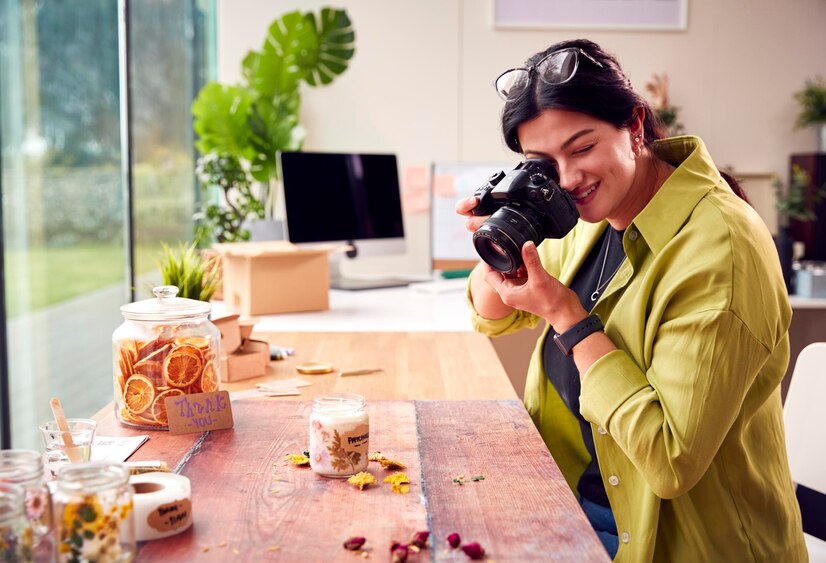If you are an e-commerce business owner or a professional photographer, you will need to know about how to get into product photography first. Amazing and professional product photography will be more effective for your business growth. It can easily impress the consumers as well as the real users.
Photography can make the first positive impression of consumers on your products. Professional and attractive product photography is used to influence the real consumers to purchase your selling products. Most importantly, professional product photography attracts your intended audience.
Today, I will share with you the details of product photography and it will be a complete and effective guideline for you to shoot product photography successfully. Have a look!
Why product photography is Important?

roduct photography is crucial for various reasons, particularly in the realms of e-commerce, marketing, and branding. Here are several key reasons why product photography is important:
1. First Impressions Matter
- Visual Appeal: High-quality product photos attract customers and create a positive first impression. They showcase the product’s best features and make it more appealing.
- Professionalism: Professional product photos signal to customers that the business is credible and trustworthy.
2. Enhances Sales and Conversion Rates
- Persuasion: Clear, detailed images help customers make informed purchasing decisions. They can see exactly what they’re buying, reducing hesitation.
- Reduced Returns: Accurate product photos can decrease the likelihood of returns, as customers have a realistic expectation of the product.
3. Competitive Advantage
- Stand Out: In a crowded market, exceptional product photos can set a brand apart from competitors. Unique and eye-catching images draw more attention.
- Brand Identity: Consistent, high-quality images contribute to a cohesive brand identity, making the brand more recognizable and memorable.
4. Supports Marketing Efforts
- Content Creation: High-quality images are essential for creating effective marketing materials, including social media posts, email campaigns, and advertisements.
- SEO Benefits: Well-optimized images can improve search engine rankings, driving more organic traffic to product pages.
5. Improves Customer Experience
- Detail and Clarity: Multiple angles, close-ups, and detailed shots help customers understand the product better, enhancing their shopping experience.
- Emotion and Storytelling: Good product photography can convey the story or lifestyle associated with the product, creating an emotional connection with customers.
7. Keeps Up with Trends
- Visual Shopping: With the rise of visual search and shoppable posts, high-quality product images are more important than ever.
- AR and VR: Enhanced product photo editing can be used in augmented reality (AR) and virtual reality (VR) applications, offering immersive shopping experiences.

Product photography: primary discussion
The most effective product photography can attract your consumer’s attention first. If you are a photographer, your photography needs to be more realistic and customized with multiple terms.
In fact, your product photos need always to highlight the amazing and most demanding features. Generally, real consumers who want to purchase products from online stores spend a lot of time reading the description. However, a realistic and attractive product image can easily attract customers. By maintaining the essential requirements of product photography, you will be more successful in your mission.
The most essential features which you will need to keep in mind before capturing-
- Consumers want to know product details from a short description of images. So, as an expert photographer, you have to try to explain details within a small portion.
- You should try to understand the angles of your product images. It will work as an effective tool for your consumer understands.
- Product photographers have to understand the requirements and demand of consumers and try to fulfill these perfectly.
- You have to gain photography skills through versatile tasks. To achieve this capability, you should apply multiple styles and designs to photos to attract real consumers.
- Keep in touch with the updated features of necessary equipment which will make your photos more trendy and elegant.
- Always try to know the trendy and current styles and designs of photos. These will be more helpful for you to make attractive product photos.

Types of product photography you should know
How to get into product photography? To be a successful photographer, you have to be expert on shooting multiple types of photographs. Photographers may focus on different parts of a photograph like cleanliness, different styles, and multiple designs, etc.
Honestly, concentrating on all of these terms is also important to get high-quality product images. Let’s know how many types of photography you should know actually-
- Individual product photo
- Multiple products shoot
- Shoot of lifestyle terms
- Detailed shots for special products
- Product measuring shots
- Product packaging shots
How to Get Into Product Photography?
Hopefully, you have got the details on professional product photographic tools and techniques. You can take this ideal discussion as a proper guideline. Do you want to get the lucrative and high-demanding product images for your product photography section? Then, you have to capture all of these essential terms which I have already discussed.
Now, let’s know the basic techniques to capture the quality product photos-
- Become a skilled photographer by practicing more and more
- After gaining proper photography knowledge, you have to build a strong portfolio
- Select the actual photography equipment and tools to capture the best
- You should find out real clients before purchasing all the equipment
- Never argue about the payment rate with your client at the beginning
- Try to provide your best effort to make quality product photos
Understanding the full requirements to get the highest quality product photos is very important. So, make a plan first to fulfill the overall requirements of a quality photo. The basic requirements of high-quality product images are-
- Quality camera and
- Effective camera lenses
Learn To Details :
Quality camera:
Most of us choose a high-range camera when we decide to purchase a camera for professional photo shoots. It’s true that a high-range camera requires many features that can positively affect tour product photos.
But, you have to remember that your camera needs to have the most demandable and necessary features to make your product images amazing, realistic, and unique. The important features which your camera should have are-
- Frames per second
- Autofocus speed
- Startup timing
- Actual speed ratings
- Resolution quality
- Zoom range
- Lens length
Effective camera lenses:
For quality product photography, you have to concentrate on high-quality camera lenses. There are multiple types of lenses with different sizes and functions. Basically, the lens selection depends on the photographer’s personal choice.
As a professional photographer, you should taste different types of lenses because they have unique features and activities. Mainly, the expensive lenses are features with good quality and performance. You should select both macro and micro lenses for your best-quality product photographs. Basic features of quality lenses are-
- Excellent transparency capacity
- High contrast level
- 3-dimensional look
- High sensor sensitivity
- High-resolution capacity
- Lenses aperture and adjustable with camera
Besides these two, some other equipment is essential for perfect and quality shoots. These further requirements will make your photos more professional and effective. Let’s know what the further equipment-
- An excellent source of light with brightness
- Shooting tethered if wi-fi or NFC is not available
- Transparent white background and quality tripod
- Wooden or acrylic plinths and risers
So, to shoot quality product images, follow and maintain all of these requirements to the best of your ability. The great combination of these two terms will provide you with amazing, high-quality product photographs.
Lighting Techniques
- Natural Light: Start with natural light, using windows and reflectors to diffuse and direct light.
- Artificial Light: Learn to use continuous lights, strobes, or speedlights. Experiment with softboxes, reflectors, and diffusers.
- Light Placement: Practice different lighting setups such as three-point lighting (key light, fill light, backlight) to see how light direction and intensity impact your product.
Learn Composition and Styling
- Rule of Thirds: Use the grid to place your product off-center for more dynamic images.
- Leading Lines and Framing: Use lines and frames within the scene to draw attention to the product.
- Background and Props: Choose complementary backgrounds and props that enhance the product without distracting from it.
Post-Processing
- Editing Software: Learn to use Adobe Lightroom and Photoshop for post-processing.
- Basic Adjustments: Adjust exposure, contrast, color balance, and sharpness.
- Advanced Techniques: Learn retouching, background removal, and compositing.
Analyze and Learn from Others
- Professional Work: Study product photos in magazines, online stores, and advertisements to understand what makes them effective.
- Feedback: Join photography forums and social media groups to get critiques on your work and learn from others.
Continuous Learning
- Online Courses: Enroll in courses on platforms like Udemy, Coursera, or Skillshare. Look for courses specifically on product photography.
- Books and Articles: Read resources like “Light Science and Magic” by Fil Hunter, Steven Biver, and Paul Fuqua.
- YouTube Tutorials: Follow channels like Peter McKinnon, Mango Street, and Karl Taylor Photography for free tutorials and tips.
Practical Steps to Start
- Set Up a Small Studio: Create a simple home studio with basic equipment like a camera, tripod, lights, and backdrops.
- Experiment: Practice with different products, lighting setups, and angles.
- Edit and Review: Post-process your images and critically review them to identify areas for improvement.
Recommended Resources
- Books: “Light Science and Magic” by Fil Hunter, Steven Biver, and Paul Fuqua for in-depth lighting techniques.
- Online Courses: CreativeLive and KelbyOne offer comprehensive courses on product photography.
- YouTube Channels: Channels like Peter McKinnon, Mango Street, and Karl Taylor Photography provide valuable tutorials and insights.
Practical Exercise
- Select a Product: Start with something simple like a small gadget or a piece of jewelry.
- Set Up Lighting: Use natural light from a window and a reflector. Take note of how the light affects the product.
- Compose the Shot: Use the rule of thirds, adjust the background, and include relevant props.
- Shoot and Review: Take multiple shots from different angles and review them critically.
- Edit the Photos: Use editing software to enhance the images, focusing on exposure, color balance, and sharpness.
By following these steps and continuously practicing, you’ll develop the skills needed to excel in product photography. Remember, consistency and practice are key to improvement
FAQ :
How Do I Choose the Right Background?
- Neutral Colors: White, black, or gray backgrounds focus attention on the product.
- Contextual Backgrounds: Use relevant backgrounds to add context and enhance the product’s appeal.
- Seamless Paper or Cloth: These are versatile and provide a clean, distraction-free backdrop.
What Are Key Composition Techniques for Product Photography?
- Rule of Thirds: Position the product off-center to create a more dynamic and balanced image.
- Leading Lines: Use lines within the scene to guide the viewer’s eye toward the product.
- Symmetry and Patterns: Utilize symmetrical compositions or repeating patterns for visually appealing shots.
How Important is Post-Processing?
- Crucial: Post-processing enhances image quality, corrects exposure, and adjusts colors.
- Software: Adobe Lightroom and Photoshop are industry standards. Free alternatives include GIMP and Darktable.
- Basic Adjustments: Focus on exposure, contrast, color balance, sharpness, and removing any imperfections.
How Can I Build a Portfolio?
- Practice Regularly: Shoot a variety of products to develop your skills and build a diverse portfolio.
- Select Best Work: Only showcase your best, most polished shots to potential clients.
- Create a Website: Use platforms like Squarespace, Wix, or WordPress to display your portfolio professionally.
Where Can I Find Clients?
- Networking: Join local photography clubs and online communities to connect with potential clients.
- Social Media: Share your work on platforms like Instagram, Pinterest, and LinkedIn to reach a wider audience.
- Freelance Platforms: Offer your services on sites like Upwork, Fiverr, and Etsy.
- Local Businesses: Approach local shops and offer your photography services for their products.
What Are Some Common Challenges and How Can I Overcome Them?
- Lighting Issues: Practice different setups and learn to use reflectors and diffusers to control light effectively.
- Limited Equipment: Start with basic gear and gradually upgrade as you earn from your photography.
- Finding Clients: Build a strong online presence, network consistently, and leverage word-of-mouth referrals.
Are There Any Recommended Courses or Books?
- Books: “Light Science and Magic” by Fil Hunter, Steven Biver, and Paul Fuqua for in-depth lighting techniques.
- Online Courses: Platforms like Udemy, Coursera, CreativeLive, and KelbyOne offer comprehensive courses on product photography.
- YouTube Channels: Follow channels like Peter McKinnon, Mango Street, and Karl Taylor Photography for valuable tutorials and insights.
Final words
How to Get Into Product Photography? I think you have a complete idea on this topic, and it will be very effective for your photography future. Don’t hurry! You have to be patient to take quality shots of images, even if it is a single one.
Finally, ensure that you have advanced skills in product photography and use high-quality equipment and tools. These concerns and consciousness will help you get attractive and effective photos with good quality. So, by ensuring all the qualities of a product shoot, you will be a successful photographer with an amazing future.

